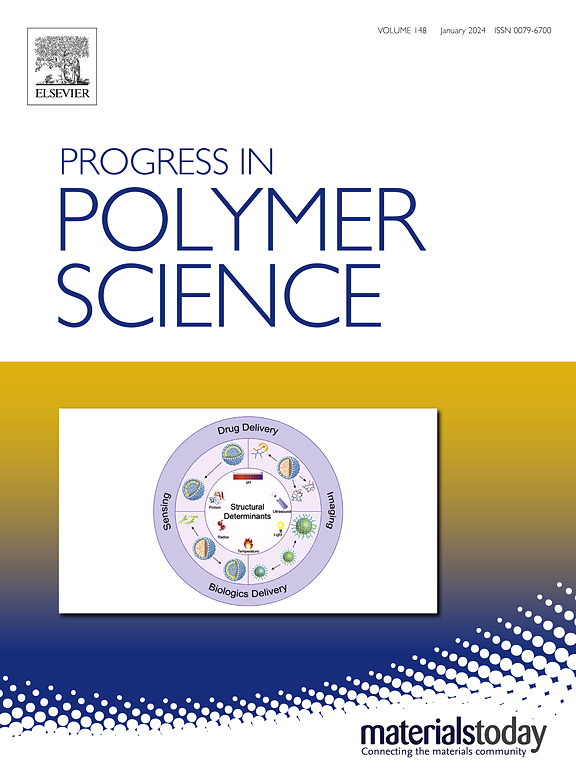Elastomeric polymer network electrolyte: Synthesis, properties, and applications
IF 26.1
1区 化学
Q1 POLYMER SCIENCE
引用次数: 0
Abstract
Elastomeric polymer network electrolytes (EPNEs) are an emerging class of materials that combine the mechanical flexibility of elastomers with the ionic conductivity of electrolytes. Conventional liquid or gel-based polymer electrolytes suffer from solvent molecule-related leakage, evaporation, and flammability issues. Solid-state polymer electrolytes offer enhanced safety but tend to be rigid, brittle, and show poor adhesion with limited ionic conductivity. EPNEs offer solvent-free solid-state ionic conduction, enabled by the segmental motion of the flexible polymer chains. Their network structures also offer superior mechanical resilience and elasticity, making them highly promising for advanced electrochemical applications. In this review, we provide a comprehensive overview of EPNEs, comparing their characteristics to other electrolytes, and highlighting the various synthetic methods and design principles employed. Key performance metrics, including ionic conductivity, mechanical strength, and operational stabilities, are discussed in the context of their applications in energy applications, wearable electronics, and soft ionotronics. By addressing the potential of EPNEs and their development directions, this review highlights their critical role in advancing next-generation electrolytes, opening new opportunities for various fields of electrochemical devices.


弹性聚合物网络电解质:合成、特性和应用
弹性体聚合物网络电解质(EPNEs)是一种新兴的材料,它结合了弹性体的机械柔韧性和电解质的离子导电性。传统的液体或凝胶聚合物电解质存在与溶剂分子相关的泄漏、蒸发和可燃性问题。固态聚合物电解质提供了增强的安全性,但往往是刚性的,脆性的,并且在有限的离子电导率下表现出较差的附着力。epne提供无溶剂的固态离子传导,通过柔性聚合物链的节段运动实现。它们的网络结构还具有优异的机械弹性和弹性,使其在先进的电化学应用中具有很大的前景。在这篇综述中,我们全面概述了EPNEs,比较了它们与其他电解质的特性,并重点介绍了各种合成方法和采用的设计原则。关键性能指标,包括离子电导率,机械强度和操作稳定性,讨论了其在能源应用,可穿戴电子和软离子电子学中的应用。本文通过对EPNEs的潜力和发展方向的分析,强调了EPNEs在推进下一代电解质方面的重要作用,为电化学器件的各个领域开辟了新的机遇。
本文章由计算机程序翻译,如有差异,请以英文原文为准。
求助全文
约1分钟内获得全文
求助全文
来源期刊

Progress in Polymer Science
化学-高分子科学
CiteScore
48.70
自引率
1.10%
发文量
54
审稿时长
38 days
期刊介绍:
Progress in Polymer Science is a journal that publishes state-of-the-art overview articles in the field of polymer science and engineering. These articles are written by internationally recognized authorities in the discipline, making it a valuable resource for staying up-to-date with the latest developments in this rapidly growing field.
The journal serves as a link between original articles, innovations published in patents, and the most current knowledge of technology. It covers a wide range of topics within the traditional fields of polymer science, including chemistry, physics, and engineering involving polymers. Additionally, it explores interdisciplinary developing fields such as functional and specialty polymers, biomaterials, polymers in drug delivery, polymers in electronic applications, composites, conducting polymers, liquid crystalline materials, and the interphases between polymers and ceramics. The journal also highlights new fabrication techniques that are making significant contributions to the field.
The subject areas covered by Progress in Polymer Science include biomaterials, materials chemistry, organic chemistry, polymers and plastics, surfaces, coatings and films, and nanotechnology. The journal is indexed and abstracted in various databases, including Materials Science Citation Index, Chemical Abstracts, Engineering Index, Current Contents, FIZ Karlsruhe, Scopus, and INSPEC.
 求助内容:
求助内容: 应助结果提醒方式:
应助结果提醒方式:


